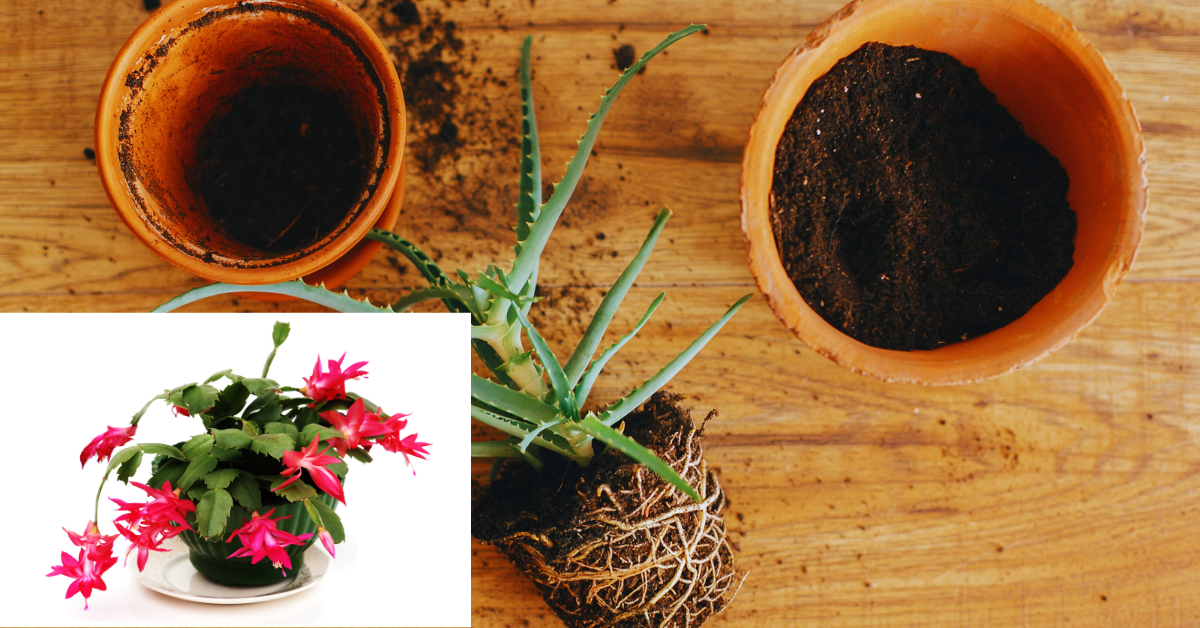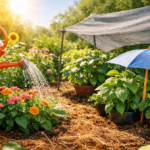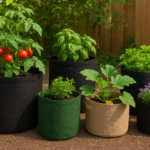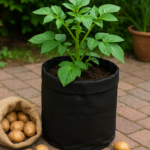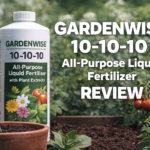The Christmas cactus is a beloved houseplant known for its vibrant blooms and unique, segmented stems. Unlike typical desert cacti, this plant hails from the rainforests of Brazil, thriving in humid, shaded environments. Because of its unique needs, its soil is crucial to its overall health and blooming potential.
Is regular potting soil suitable for your Christmas cactus? While it’s tempting to use what’s readily available, regular potting soil can be too dense and retain excessive moisture, leading to root rot and other issues. Christmas cacti prefer a well-draining, airy mix that mimics their natural habitat. To keep your plant thriving, it’s best to use a specialized cactus or succulent potting mix or amend regular potting soil with sand, perlite, or orchid bark to enhance drainage. Understanding and meeting your Christmas cactus’s soil needs will set the stage for a healthy, flourishing plant.
About Christmas cactus

The Christmas cactus, also known as Schlumbergera, is a popular houseplant admired for its striking, tubular flowers that bloom around the holiday season. Unlike traditional cacti, this plant originates from the tropical rainforests of Brazil, where it grows as an epiphyte on trees, thriving in humid, shaded conditions. It has flat, segmented stems with scalloped edges that can grow into cascading branches, making it a beautiful addition to hanging baskets or as a tabletop display.
Christmas cacti thrive on indirect light, moderate watering, and well-draining soil. They are sensitive to overwatering, so it’s crucial to let the top layer of soil dry out between waterings. With the right care, this resilient plant can live for decades and become a cherished part of holiday traditions with its bright pink, red, or white blooms.
To know more about Christmas cactus: How to Make a Christmas Cactus Bloom : Expert Tips Revealed
Importance of Proper Soil for Healthy Growth of Christmas Cactus
Choosing the suitable soil for your Christmas cactus is essential for its health and longevity. Here’s why proper soil matters:
- Drainage: Christmas cacti are prone to root rot if left in soggy soil. A well-draining mix allows excess water to escape, preventing soggy conditions that can damage roots.
- Aeration: Proper soil structure provides ample air pockets that promote root respiration. Good aeration is crucial for nutrient uptake and overall plant vitality, helping the cactus grow more muscular and bloom more abundantly.
- Moisture Retention Balance: While Christmas cacti need good drainage, they also require consistent moisture. A balanced soil mix retains just enough moisture without becoming compacted, maintaining a healthy environment for the roots.
- Nutrient Availability: The right soil mix can supply essential nutrients or facilitate the addition of fertilizers. Well-formulated soils often contain organic matter that slowly releases nutrients, supporting the cactus’s growth needs.
- pH Level: Christmas cacti prefer a slightly acidic to neutral pH. Proper soil helps maintain this pH range, ensuring the plant can absorb nutrients efficiently.
Read How important potting soil are: Why won’t my Christmas cactus bloom: the Secrets Behind a Non-Blooming
What is Regular Potting Soil?

Regular potting soil, or mix, is a general-purpose growing medium for various indoor and outdoor plants. It’s designed to provide the essential components for plant growth, including support, nutrients, and moisture retention. However, not all plants thrive in the same soil type, so understanding the composition and suitability of regular potting soil for specific plants, such as the Christmas cactus, is essential.
More about potting soil: What is the best potting soil for indoor plants?
Composition of Standard Potting Mixes
Standard potting mixes are typically composed of organic and inorganic materials designed to provide a balanced environment for root growth. The primary components include:
- Peat Moss: Helps retain moisture and provides organic matter to the mix.
- Compost: Adds nutrients and improves soil structure.
- Perlite or Vermiculite: Lightweight minerals that improve aeration and drainage.
- Sand: Sometimes included to enhance drainage.
- Lime: Used to adjust the pH, especially when peat moss is a significant component.
These elements work together to create a mix generally suitable for most houseplants, offering a balance of water retention, drainage, and nutrient availability.
Typical Uses and Suitability
Regular potting soil is commonly used for growing various indoor and outdoor potted plants, such as flowers, vegetables, and herbs. It’s ideal for plants that prefer a moderately moist, nutrient-rich environment. However, it may not be suitable for plants with specific needs, like succulents and cacti, which require a more specialized, well-draining soil mix.
For Christmas cacti, regular potting soil can hold too much moisture, increasing the risk of root rot. Therefore, it’s often recommended to use a specialized cactus or succulent mix or to amend regular potting soil with additional drainage materials like sand, perlite, and orchid bark to better suit the needs of Christmas cacti.
Differences Between Regular Potting Soil and Cactus Soil
When choosing the right soil for your plants, understanding the differences between regular potting soil and cactus soil is crucial. its Also need to know if the potting soil goes bad or okay? Each type of soil is formulated to meet the specific needs of different plants, and using the right mix can make a significant difference in plant health and growth.
Soil Drainage and Aeration
- Regular Potting Soil: Regular potting soil tends to retain moisture more effectively due to its composition, which often includes peat moss and compost. While this benefits many indoor plants that prefer consistent moisture, it can be detrimental to plants that require excellent drainage. The moisture retention can lead to waterlogged conditions and potential root rot, especially for plants like cacti that are sensitive to excess water.
- Cactus Soil: Cactus soil is designed to provide superior drainage and aeration. It typically includes a mix of perlite, coarse sand, and pumice, creating a loose, well-draining environment. This ensures that excess water drains quickly, reducing the risk of root rot and allowing the plant’s roots to breathe. This type of soil mimics the natural conditions of desert environments, where cacti thrive.
pH Levels and Nutrient Balance
- Regular Potting Soil: Regular potting soil’s pH level is usually slightly acidic to neutral, which works well for a broad range of plants. However, the nutrient content can vary widely, and the mix might be rich in organic matter that decomposes over time, potentially altering the pH and nutrient balance. This isn’t an issue for many houseplants, but it may not be ideal for plants with more specific requirements.
- Cactus Soil: Cactus soil is formulated to maintain a slightly acidic to neutral pH, which aligns with the needs of cacti. It often contains minimal organic matter, which helps prevent the soil from becoming too acidic or too rich in nutrients. The low nutrient content is intentional, as cacti are adapted to nutrient-poor environments. This type of soil ensures that nutrients are available without being overwhelming, which is crucial for the health of cactus plants.
Read review if Need best soil mix: Best indoor plant potting soil for indoor plants: (Review 2024)
How to Repot Your Christmas Cactus

Repotting your Christmas cactus is an integral part of its care routine. It ensures the plant has enough space to grow, fresh soil, and optimal conditions for health and blooming. Here’s a step-by-step guide on how to report your Christmas cactus:
- Choose the Right Time: The best time to repot is after the blooming period, typically in late winter or early spring. Avoid repotting during the blooming season, as this can stress the plant.
- Select a Suitable Pot: Choose a pot slightly larger than the current one, ideally 1-2 inches wider in diameter. Ensure it has drainage holes to prevent waterlogging.
- Prepare the New Soil: Use a well-draining soil mix, such as a cactus or succulent mix. If you’re modifying regular potting soil, incorporate perlite, coarse sand, orchid bark to improve drainage.
- Remove the Plant: Gently remove the Christmas cactus from its current pot. Be careful not to damage the roots. You can use a small trowel or your fingers to loosen the soil around the edges.
- Inspect and Prune Roots: Examine the roots for any signs of rot or damage. Trim away any unhealthy roots with sterilized scissors. Healthy roots should be firm and white.
- Place in the New Pot: Add a layer of the new soil mix to the bottom of the pot. Position the Christmas cactus in the centre and fill around the roots with soil. Press down to remove air pockets, but avoid compacting the soil too much.
- Water Lightly: Water the cactus lightly after repotting to help settle the soil. Allow the top layer to dry out before watering again. Overwatering right after repotting can lead to root rot.
- Provide Proper Light: Place the repotted cactus in a location with bright, indirect light. Avoid direct sunlight, which can stress the plant.
- Monitor and Adjust Care: Monitor the cactus over the next few weeks. Adjust your watering schedule as needed, and ensure the plant acclimates well to its new pot.
Can Christmas Cactus Survive in Regular Potting Soil?
Christmas cacti can survive in regular potting soil, but it’s not always ideal for long-term health. While regular potting soil offers good moisture retention and nutrient availability, it can present challenges for Christmas cacti due to its moisture-holding properties and density.
Key Considerations:
- Moisture Retention: Regular potting soil retains moisture more than cactus soil, which can lead to overly wet conditions. Christmas cacti are sensitive to excess moisture, and waterlogged soil can cause root rot, a common issue with this plant.
- Drainage: The lack of drainage in regular potting soil can be problematic. Christmas cacti prefer well-draining soil to prevent stagnant water around their roots. Without adequate drainage, the risk of root rot increases, potentially affecting the plant’s overall health.
Possible Solutions:
- Amend the Soil: To make regular potting soil more suitable for a Christmas cactus, you can amend it with materials that enhance drainage. Adding perlite, coarse sand, and orchid bark can improve soil aeration and reduce moisture retention.
- Monitor Watering: If you use regular potting soil, be vigilant about watering. Allow the top inch or so of soil to dry out between waterings to prevent water from accumulating around the roots.
Potential Problems with Using Regular Potting Soil for Christmas Cactus
Using regular potting soil for your Christmas cactus can lead to several issues that affect the plant’s health and growth. Here are some potential problems to be aware of:
- Excess Moisture: Regular potting soil retains more moisture compared to cactus soil. Christmas cacti are prone to root rot if their roots are constantly wet. The moisture-holding capacity of regular potting soil can create a damp environment that is not ideal for these plants.
- Poor Drainage: Regular potting mixes often lack the drainage properties required by Christmas cacti. Water can accumulate around the roots without proper drainage, leading to waterlogged conditions and potential root rot.
- Compacted Soil: The texture of regular potting soil can become compacted over time, reducing aeration and hindering root growth. Christmas cacti need well-aerated soil to support healthy root development.
- Nutrient Imbalance: Regular potting soil may be rich in nutrients, which can be too much for a Christmas cactus. Excess nutrients can lead to overly rapid growth or reduced blooming.
How to Modify Regular Potting Soil for Christmas Cactus
If you prefer using regular potting soil for your Christmas cactus, you can enhance it to better suit the plant’s needs. Here’s how to modify regular potting soil to create a more suitable environment for your Christmas cactus:
- Add Perlite: Mix in perlite, a lightweight, volcanic mineral that improves soil aeration and drainage. Aim for a ratio of about 1 part perlite to 1 part regular potting soil. This helps prevent the soil from becoming compacted and allows excess water to drain more effectively.
- Incorporate Coarse Sand: Adding coarse sand to the potting soil can further enhance drainage. Mix about 1 part sand with 1 part potting soil. Coarse sand helps to prevent the soil from retaining too much moisture, mimicking the drier conditions that Christmas cacti prefer.
- Include Orchid Bark: Orchid or pine bark can also improve soil structure. Mix in a small amount, about 1 orchid bark, to 2 parts regular potting soil. The bark adds air pockets and helps with drainage.
- Adjust pH Levels: Christmas cacti thrive in slightly acidic to neutral soil. Regular potting soil can sometimes be too acidic or alkaline. Check the pH and, if necessary, adjust it using lime to raise the pH or sulfur to lower it.
- Avoid Over-Fertilizing: Regular potting soil may come with a nutrient boost. However, Christmas cacti don’t require as many nutrients. Use a balanced, diluted fertilizer sparingly to prevent over-fertilization, which can affect blooming.
Tips for Maintaining Healthy Soil Conditions
Keeping the soil in optimal condition is crucial for the health of your Christmas cactus and other plants. Here are some tips to ensure your soil remains healthy and supportive of plant growth:
Ensure Proper Drainage:
Use a well-draining soil mix and ensure your pots have drainage holes. This prevents water from accumulating at the bottom and reduces the risk of root rot. If using regular potting soil, amend it with perlite or coarse sand to enhance drainage.
Avoid Overwatering:
Water your Christmas cactus only when the top inch of soil feels dry. Overwatering is a common cause of root rot and other issues. Adjust your watering frequency based on the plant’s needs and the season.
Monitor Soil Moisture:
Invest in a moisture meter or use your finger to check soil moisture levels. This helps you avoid overwatering and underwatering, keeping the soil at the proper moisture level.
Maintain Proper pH Levels:
Check the pH of your soil periodically. Christmas cacti prefer a slightly acidic to neutral pH. If the soil becomes too acidic or alkaline, adjust it using lime to raise the pH or sulfur to lower it.
Add Organic Matter:
Periodically incorporate organic matter such as compost or well-rotted manure into the soil. This provides essential nutrients and improves soil structure. For cacti, use this sparingly and avoid overly rich amendments.
Avoid Soil Compaction:
Regularly check and loosen compacted soil, especially in pots. Compact soil restricts root growth and affects aeration. Gently fluff the soil surface with a fork or trowel to maintain its loose structure.
Refresh the Soil:
Every 1-2 years, consider refreshing or replacing the top layer of soil to replenish nutrients and remove any built-up salts or debris. This can also help rejuvenate the plant’s growing environment.
Use Mulch Wisely:
While Mulch is generally used to retain moisture, it’s less critical for cacti. If you use Mulch, opt for a light layer and ensure it does not trap excessive moisture around the roots.
FAQs
- How often should I repot my Christmas cactus?
Report your Christmas cactus every 2-3 years or when you notice it is becoming root-bound or outgrowing its pot. The best time to repot is after the blooming period, typically in late winter or early spring.
- What kind of soil is best for a Christmas cactus?
A well-draining cactus or succulent mix is best for Christmas cacti. These mixes are designed to balance drainage and moisture retention, mimicking the cactus’s natural rainforest habitat.
- How can I tell if my Christmas cactus is overwatered?
Signs of overwatering include yellowing or wilting leaves, a mushy stem, and a musty smell from the soil. To prevent these issues, make sure the top inch of soil dries out between waterings.
- What should I do if my Christmas cactus develops root rot?
If your Christmas cactus shows signs of root rot, remove it from its pot and trim away the affected roots with sterile scissors. Repot the plant in fresh, well-draining soil and adjust your watering routine to prevent future issues.
Conclusion
Proper soil conditions are vital for the health of your Christmas cactus. Using the right mix, ensuring good drainage, and monitoring moisture levels can prevent common issues like root rot and nutrient imbalances. While regular potting soil can be modified to suit your cactus, opting for a specialized cactus mix often provides the best results. By maintaining optimal soil conditions and adjusting your care routine, you’ll help your Christmas cactus thrive and enjoy vibrant blooms year after year.

